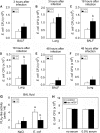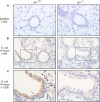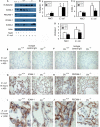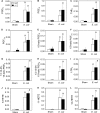Group V phospholipase A2 in bone marrow-derived myeloid cells and bronchial epithelial cells promotes bacterial clearance after Escherichia coli pneumonia
- PMID: 21849511
- PMCID: PMC3195628
- DOI: 10.1074/jbc.M111.262733
Group V phospholipase A2 in bone marrow-derived myeloid cells and bronchial epithelial cells promotes bacterial clearance after Escherichia coli pneumonia
Abstract
Group V-secreted phospholipase A(2) (GV sPLA(2)) hydrolyzes bacterial phospholipids and initiates eicosanoid biosynthesis. Here, we elucidate the role of GV sPLA(2) in the pathophysiology of Escherichia coli pneumonia. Inflammatory cells and bronchial epithelial cells both express GV sPLA(2) after pulmonary E. coli infection. GV(-/-) mice accumulate fewer polymorphonuclear leukocytes in alveoli, have higher levels of E. coli in bronchoalveolar lavage fluid and lung, and develop respiratory acidosis, more severe hypothermia, and higher IL-6, IL-10, and TNF-α levels than GV(+/+) mice after pulmonary E. coli infection. Eicosanoid levels in bronchoalveolar lavage are similar in GV(+/+) and GV(-/-) mice after lung E. coli infection. In contrast, GV(+/+) mice have higher levels of prostaglandin D(2) (PGD(2)), PGF(2α), and 15-keto-PGE(2) in lung and express higher levels of ICAM-1 and PECAM-1 on pulmonary endothelial cells than GV(-/-) mice after lung infection with E. coli. Selective deletion of GV sPLA(2) in non-myeloid cells impairs leukocyte accumulation after pulmonary E. coli infection, and lack of GV sPLA(2) in either bone marrow-derived myeloid cells or non-myeloid cells attenuates E. coli clearance from the alveolar space and the lung parenchyma. These observations show that GV sPLA(2) in bone marrow-derived myeloid cells as well as non-myeloid cells, which are likely bronchial epithelial cells, participate in the regulation of the innate immune response to pulmonary infection with E. coli.
Figures








Similar articles
-
Alveolar epithelial STAT3, IL-6 family cytokines, and host defense during Escherichia coli pneumonia.Am J Respir Cell Mol Biol. 2008 Jun;38(6):699-706. doi: 10.1165/rcmb.2007-0365OC. Epub 2008 Jan 10. Am J Respir Cell Mol Biol. 2008. PMID: 18192501 Free PMC article.
-
TREM2 Dictates Antibacterial Defense and Viability of Bone Marrow-derived Macrophages during Bacterial Infection.Am J Respir Cell Mol Biol. 2021 Aug;65(2):176-188. doi: 10.1165/rcmb.2020-0521OC. Am J Respir Cell Mol Biol. 2021. PMID: 33848212
-
Group V secreted phospholipase A2 contributes to LPS-induced leukocyte recruitment.J Cell Physiol. 2010 Jul;224(1):127-34. doi: 10.1002/jcp.22106. J Cell Physiol. 2010. PMID: 20232296
-
Toll/IL-1 receptor domain-containing adaptor inducing IFN-beta (TRIF)-mediated signaling contributes to innate immune responses in the lung during Escherichia coli pneumonia.J Immunol. 2007 Mar 1;178(5):3153-60. doi: 10.4049/jimmunol.178.5.3153. J Immunol. 2007. PMID: 17312163
-
Immunohistochemical detection of sepsis-induced lung injury in human autopsy material.Leg Med (Tokyo). 2003 Jun;5(2):73-86. doi: 10.1016/s1344-6223(03)00010-5. Leg Med (Tokyo). 2003. PMID: 12935535 Review.
Cited by
-
Old but New: Group IIA Phospholipase A2 as a Modulator of Gut Microbiota.Metabolites. 2022 Apr 14;12(4):352. doi: 10.3390/metabo12040352. Metabolites. 2022. PMID: 35448539 Free PMC article. Review.
-
The ubiquitin-CXCR4 axis plays an important role in acute lung infection-enhanced lung tumor metastasis.Clin Cancer Res. 2013 Sep 1;19(17):4706-16. doi: 10.1158/1078-0432.CCR-13-0011. Epub 2013 May 20. Clin Cancer Res. 2013. PMID: 23690484 Free PMC article.
-
In vitro anti-Plasmodium falciparum properties of the full set of human secreted phospholipases A2.Infect Immun. 2015 Jun;83(6):2453-65. doi: 10.1128/IAI.02474-14. Epub 2015 Mar 30. Infect Immun. 2015. PMID: 25824843 Free PMC article.
-
Lipoquality control by phospholipase A2 enzymes.Proc Jpn Acad Ser B Phys Biol Sci. 2017;93(9):677-702. doi: 10.2183/pjab.93.043. Proc Jpn Acad Ser B Phys Biol Sci. 2017. PMID: 29129849 Free PMC article. Review.
-
Secretory Phospholipase A2 Enzymes in Acute Lung Injury.Cell Biochem Biophys. 2021 Sep;79(3):609-617. doi: 10.1007/s12013-021-01003-x. Epub 2021 Jun 8. Cell Biochem Biophys. 2021. PMID: 34105094 Free PMC article. Review.
References
-
- Kochanek K. D., Smith B. L. (2004) Natl. Vital Stat. Rep. 52, 1–47 - PubMed
-
- Niederman M. S., McCombs J. S., Unger A. N., Kumar A., Popovian R. (1998) Clin. Ther. 20, 820–837 - PubMed
-
- Zhang P., Summer W. R., Bagby G. J., Nelson S. (2000) Immunol. Rev. 173, 39–51 - PubMed
-
- Greenberg S., Grinstein S. (2002) Curr. Opin. Immunol. 14, 136–145 - PubMed
-
- Lambeau G., Gelb M. H. (2008) Annu. Rev. Biochem. 77, 495–520 - PubMed
Publication types
MeSH terms
Substances
Grants and funding
LinkOut - more resources
Full Text Sources
Medical
Miscellaneous

